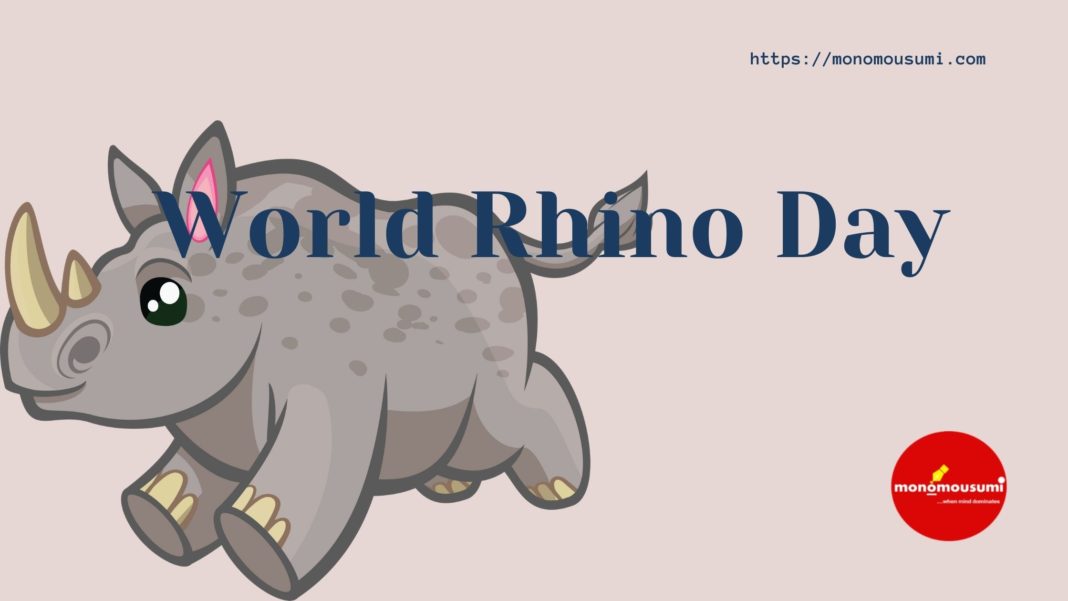We celebrate World Rhino Day on the 22nd of September. Rhinos, the animals having a pretty hard and muscular body with one or two horns. These horns which we find so much fascinating are a major cause of their killings.
World Rhino Day was proclaimed by the World Wildlife Fund-South Africa in 2010. World Rhino Day became an international success just after one year in 2011. Since then, NGOs, zoos, wildlife sanctuaries, biospheres, and concerned individuals around the world unite with each other to celebrate their year of success, taking care of them and saving the rhinos from getting poached.
World Rhino Day celebrates five species of Rhinos around the world, these are:
- Black Rhino: – These beautiful beasts are mainly found in Africa, mostly in grasslands, savannahs, and tropical bushlands.
- White Rhino: – These adorable creatures occur in Africa, in long and short-grass savannahs.
- Sumatran Rhino: – These pleasing characters live in dense tropical forests, both lowland, and highland, especially on the Indonesian isle of Sumatra.
- Greater One-Horned Rhino: – These muscular and charming beings are largely seen in northern India and southern Nepal, in riverine (floodplain) grasslands and adjacent woodland.
- Javan Rhino: – These absolute animals are located only in Indonesia’s Ujung Kulon National Park in West Java.
Black Rhinos have two horns. The front horn is larger and averages 20-55 inches (0.5-1.3 m). The rear horn is smaller and sizes up to 22 inches (55 cm) long. Their weight varies from 1,750-3,000 lbs (800-1,350 kg). They are 4.5-5.5 ft (1.4-1.7 m) tall at the shoulder. Their length from head and body is 10-12.5 ft (3.0-3.8 m). There are three black-rhino sub-species. Black Rhinos are browsers (a type of herbivory in which a herbivore feeds on leaves, soft shoots or fruits, etc.), their prehensile upper lip is adapted for grasping and holding leaves and branches of shrubs and trees. They can survive up to 35-40 years in the wild.
White Rhinos have two horns. The larger front horn averages 37-79 inches (94-201 cm). The rear horn levels up to 22 inches (55 cm) long. Their weight varies from 4,000-6,000 lbs (1,800-2,700 kg). They are 5-6 feet (1.5-1.8 m) towering at the shoulder. Their length from head to body is 10-16 feet (3-5 m). Only five countries hold 99% of Africa’s White Rhinos-the vast majority of those in South Africa. White rhinos are grazers (a method of feeding in which a herbivore feeds on low-growing plants such as grasses or other multicellular organisms, such as algae), their wide square upper lip is adapted for feeding on grasses. White Rhinos can live up to 35-40 years of age.
Sumatran Rhino has two horns. The front horn is bigger and measures 10-31 inches (25-79 cm) long. The second horn is tinier, generally less than 3 inches (10 cm). Their weight varies from 1,300-2,000 pounds (600-950 kg). They are 3-5 feet (1.0-1.5 m) tall till shoulder. Their length of the body is 6.5-9.5 feet (2.0-3.0 m). This species is a browser and an opportunistic feeder with very diverse nutrition that may include more than 100 plant species. Sumatran Rhinos live up to 35-40 years.
Greater One-Horned Rhino has a single horn that is 8-24 inches (20-61 cm) long. These animals are grazers. When not munching on land, animals like to submerge themselves in water, where they also graze on aquatic plants.
Javan Rhino possesses a single horn which is 10 inches (25 cm) long in males, females having smaller or no horns. These rhinos seem to be more adaptable feeders than different rhino species. In the tropical rainforests where the species now survive, it is a pure browser, but it is possibly a mixed feeder (browser and grazer) in other parts of its historic range. Biologists have recognized more than 300 different species that comprise their diet. Survival is unknown, but Javan Rhinos probably live up to 30-40 years.
Because of their hard skin and deadly horns, rhino does not have many natural predators. Even then the population of rhinos is declining dramatically. Today, only 5,500 Black Rhinos are there, approximately 18,000 White Rhinos, less than 80 Sumatran Rhino survive in fragmented populations in Indonesia’s Bukit Barisan, Gunung Leuser, and Way Kambas National Parks, and a small population was lately found in central Kalimantan. Currently, 72 Javan Rhinos are surviving in one city, Indonesia and there are 3,600 Great One-Horned Rhino in wild.
World Rhino Day is a time to spread awareness on how to save rhinos. Zoos, reserves, and rhino sanctuaries host a variety of events. World Rhino Day is especially popular in Africa.
If you want to engage in World Rhino Day, learn about rhinos. If your nearby zoo has a rhino exhibition, go and check it out. Make sure you use your money wisely. Just try and invest/put or use some of your money in a good and positive thing that can change your surroundings, then change your environment, then your society, slowly your community, and after some time you can change the world. No doubt many obstacles will come in your way but keep on moving, and think about the happiness and proudness that you will feel when you will make someone or a million individuals happy; either it is an animal or a person. Everything is not just about getting some stuff, by helping others you feel the good and positive aura and energy in your surroundings. You feel healthy and complete. By giving, you are like a healer for society; you are playing your part and performing your responsibility to make our world a better place.And if you cannot donate then just support the right things, respect every individual, spread awareness, and prevent bad things. And lastly, help every individual survive. Happy Rhino Day!
By Shruti Singh, Maharashtra










